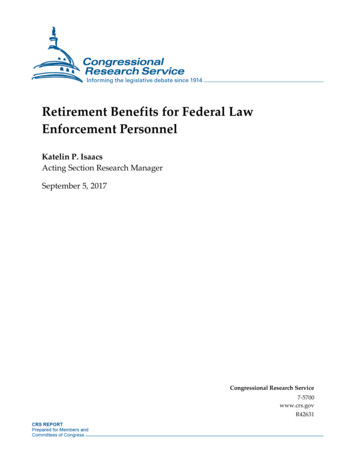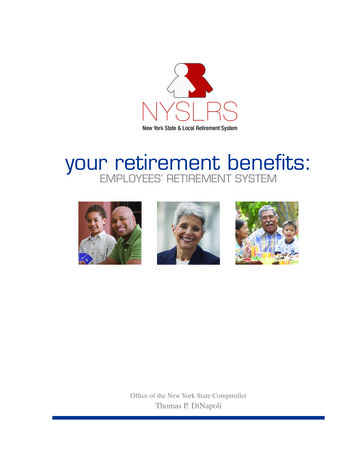
Transcription
Retirement Benefits for Federal LawEnforcement PersonnelKatelin P. IsaacsActing Section Research ManagerSeptember 5, 2017Congressional Research Service7-5700www.crs.govR42631
Retirement Benefits for Federal Law Enforcement PersonnelSummaryFederal employees who perform specific duties, as defined in statute, are classified as lawenforcement officers (LEOs) for the purpose of federal retirement benefits. LEOs and a fewlegislatively designated groups, including federal firefighters and air traffic controllers, areeligible for enhanced retirement benefits under the Civil Service Retirement System (CSRS), forindividuals hired before 1984, or the Federal Employees’ Retirement System (FERS), forindividuals hired in 1984 or later.The availability of enhanced retirement benefits for LEOs and similar groups is linked to anexpectation of limited federal service. This limited service is due, in turn, to the rigorous physicaldemands of law enforcement duties and the mandatory retirement age to which these individualsare subject. LEO enhanced retirement benefits are designed to provide adequate retirementincome for federal employees with careers that end at an earlier age with fewer years of servicethan regular civilian federal employees.In general, law enforcement personnel are subject to mandatory retirement at age 57, or as soonas 20 years of service have been completed after age 57. The maximum age of entry, which isintended to ensure full retirement benefits upon reaching mandatory retirement age, is typicallyage 37. Under both CSRS and FERS, law enforcement personnel are eligible for their enhancedbenefits at the age of 50 provided they have completed the minimum requirement of 20 years ofservice. Under FERS, law enforcement personnel with 25 years of service are eligible forretirement regardless of age.Law enforcement personnel in CSRS and their employing agencies each contribute 7.5% ofpayroll. CSRS law enforcement personnel accrue benefits at the rate of 2.5% per year for theirfirst 20 years of service and 2% for each year after the 20th year of service. Law enforcementpersonnel in FERS accrue benefits at the rate of 1.7% per year for the first 20 years of service and1% per year for each year thereafter. FERS contribution rates vary by date of hire. Lawenforcement personnel in FERS first hired before 2013 contribute 1.3% of pay (plus SocialSecurity contributions), and their agencies contribute 30.1% of pay. Under P.L. 112-96, FERS lawenforcement personnel first hired in 2013 contribute 3.6% of pay (plus Social Securitycontributions), and their agencies contribute 28.4% of pay. Finally, under P.L. 113-67, FERS lawenforcement personnel first hired in 2014 or later contribute 4.9% of pay (plus Social Securitycontributions), but their agencies still contribute 28.4% of pay. FERS accrual rates remainunchanged for law enforcement personnel first hired in 2013 or later (including individuals firsthired in 2014 or later).Many employees in law enforcement occupations are not recognized as LEOs by their agenciesand OPM for the purposes of federal retirement coverage and, consequently, are not eligible toreceive enhanced retirement benefits. Several employee groups and unions representingindividuals in these occupations have sought enhanced retirement benefits through additionallegislation. Recent Congresses have responded by introducing legislation that would provideenhanced retirement benefits to additional personnel. Though granting more groups such benefitsmay alleviate problems of attrition and perceived inequity across law enforcement occupations, itwould also increase personnel costs for employing agencies as well as overall federalexpenditures on civilian federal retirement benefits.Congressional Research Service
Retirement Benefits for Federal Law Enforcement PersonnelContentsIntroduction . 1Federal Law Enforcement Officers and Related Personnel . 1Statutory Definition of a Law Enforcement Officer. 1Additional Regulations Defining LEOs . 2Administrative Process for Determining LEO Status . 2Legislative Rationale for Enhanced Retirement Benefits. 4Retirement Coverage for Federal Law Enforcement Personnel . 5Civil Service Retirement System . 5Federal Employees’ Retirement System. 5Eligibility and Benefit Amounts Under CSRS and FERS . 6Age and Length of Service Requirements. 6Mandatory Retirement . 6Maximum Age of Entry . 6Minimum Retirement Age . 7Required Contributions . 7Contributions Under CSRS . 7Contributions Under FERS . 7Pension Plan Benefits. 8High-Three Average Salary. 8Accrual Rates . 8Pension Formulas . 8Federal Law Enforcement Personnel with Both CSRS and FERS Coverage . 9The FERS Supplement . 9Cost-of-Living Adjustments . 9Replacement Rates . 10Extending Enhanced Benefits to Other Occupational Groups . 12TablesTable 1. Major Occupational Groups Eligible for Enhanced Benefits . 3Table 2. Major Occupational Groups Added to the Definition of a LEO or Provided withLEO-Equivalent Benefits via Direct Legislation . 3Table 3. Summary of Retirement Benefits for Federal Law Enforcement Personnel . 11ContactsAuthor Contact Information . 13Congressional Research Service
Retirement Benefits for Federal Law Enforcement PersonnelIntroductionFederal law enforcement officers, as defined in statute, and a few related occupations—such asfederal firefighters and air traffic controllers—are eligible for enhanced retirement benefits.Congress decided that these occupations should be composed of young men and women whopossess the strength and endurance necessary to perform the required duties. Enhanced retirementbenefits help to maintain this type of workforce by permitting employees in these positions toretire earlier and accrue pension benefits faster during earlier years of service than regular civilianfederal employees. Many individuals and employee groups who work in law enforcement-relatedpositions, but who have not qualified as law enforcement officers for retirement purposes, havesought enhanced benefits through legislation in recent Congresses. Incorporating additionaloccupations may address problems of attrition and perceived inequity across law enforcementrelated positions. However, expanding access to enhanced retirement benefits also generatesconcerns over additional expenditures on federal retirement benefits.Federal Law Enforcement Officers andRelated PersonnelCurrently, the definition of a federal law enforcement officer (LEO) for retirement purposes islimited to an employee who performs certain duties defined in statute under either the CivilService Retirement System (CSRS), which covers federal employees hired before 1984, or theFederal Employees’ Retirement System (FERS), which covers federal employees hired in 1984 orlater. Individuals employed in positions that meet the statutory definition of a LEO, as well ascertain personnel who have obtained LEO-equivalent benefits through direct legislation, areeligible to retire earlier with fewer years of service and receive a benefit accrual rate during thefirst 20 years of service that is higher than the benefit accrual rate for regular federal civilianemployees. LEOs and employees who have enhanced retirement benefits also contribute more totheir own benefits than regular civilian federal employees and are subject to a mandatoryretirement age.Statutory Definition of a Law Enforcement OfficerUnder CSRS, a LEO is an employee whose primary duties are “the investigation, apprehension,or detention of individuals suspected or convicted of offenses against the criminal laws of theUnited States, including an employee engaged in this activity who is transferred to a supervisoryor administrative position.”1The definition of a LEO under FERS is nearly identical to the CSRS definition, though morespecific. In addition to an employee whose primary duties are “the investigation, apprehension, ordetention of individuals suspected or convicted of offenses against the United States,” the FERSdefinition includes an employee whose primary duties are “the protection of officials of theUnited States against threats to personal safety.”2 The FERS statutory definition of a LEO also15 U.S.C. §8331(20). “Primary duties” are defined by the U.S. Code of Federal Regulations (5 C.F.R. §831.802) as“those duties of a position which—(a) Are paramount in influence or weight; that is, constitute the basic reasons for theexistence of the position; (b) Occupy a substantial portion of the individual’s working time over a typical work cycle;and (c) Are assigned on a regular and recurring basis. Duties that are of an emergency, incidental, or temporary naturecannot be considered “primary” even if they meet the substantial portion of time criterion.”25 U.S.C. §8401(17).Congressional Research Service1
Retirement Benefits for Federal Law Enforcement Personnelprovides an explicit standard for rigorous duty. For those employees whose primary duties are asdescribed above, these duties must be “sufficiently rigorous that employment should be limited toyoung and physically vigorous individuals.”3Additional Regulations Defining LEOsThe implementing regulations for the Office of Personnel Management (OPM), whichadministers CSRS and FERS benefits, establish that the definition of a law enforcement officer“does not include an employee whose primary duties involve maintaining law and order,protecting life and property, guarding against or inspecting for violations of law, or investigatingpersons other than persons who are suspected or convicted of offenses against the criminal lawsof the United States.”4Furthermore, qualification for enhanced retirement benefits does not depend on the lawenforcement mission of an agency, nor does it depend on the classification of a position within anoccupational series of the Federal Classification and Job Grading System. Effectively, this hasexcluded police officers, guards, and inspectors from the definition of “law enforcement officer”for federal retirement purposes.Administrative Process for Determining LEO StatusTypically, for a group of employees to be eligible for enhanced retirement benefits under CSRS orFERS, the employing agency must determine that the duties of the position meet the statutorydefinition of a LEO and submit their evaluation to OPM. OPM rarely overturns the decision ofthe head of an agency but retains the right to do so.5 Alternatively, some groups whose agenciesand OPM have determined that they do not meet the statutory definition of a LEO have gainedaccess to enhanced retirement benefits through direct legislation that either added them to thestatutory definition of a LEO or provided benefits similar to those received by LEOs. If anemployee feels that he or she has been unjustly excluded from the LEO definition and theconcomitant retirement benefits, that individual may appeal the final decision of the relevantagency to the Merit Systems Protection Board.6Table 1 provides a list of groups of employees eligible for enhanced retirement benefits as a LEOor similar position. The left column includes examples of groups of employees that meet thestatutory definition of a LEO under CSRS or FERS. The right column lists employee groups thathave either been added to the LEO definition or granted enhanced retirement benefits throughdirect legislation. As described above, LEO determinations are made on the basis of positionduties or by direct legislation. Therefore, the list in Table 1 is presented for illustrative purposesand is not intended to be exhaustive.35 U.S.C. §§8401(14) and 8401(17), respectively. A “rigorous position” is defined in federal regulations (5 C.F.R.§3307(e)) as “a position the duties of which are so rigorous that employment opportunities should, as soon asreasonably possible, be limited (through establishment of a maximum entry age and physical qualifications) to youngand physically vigorous individuals.”45 C.F.R. §831.920.5U.S. Government Accountability Office, Federal Law Enforcement Retirement: Information on Enhanced RetirementBenefits for Law Enforcement Personnel, GAO-09-727, July 2009. (Hereafter cited as GAO-09-727.)65 C.F.R. §§831.308 and 841.308.Congressional Research Service2
Retirement Benefits for Federal Law Enforcement PersonnelTable 1. Major Occupational Groups Eligible for Enhanced BenefitsMeet LEO Definitional Criteria via OPMAdministrative ProcessBorder Patrol AgentsDrug Enforcement Administration Special AgentsFBI Special AgentsFederal Air MarshalsImmigration Enforcement Agents andDetention/Deportation OfficersIRS Special AgentsU.S. MarshalsU.S. Park RangersU.S. Secret Service Special AgentsAdded to LEO Definition or Provided LEOEquivalent Benefits via Direct LegislationAir Traffic ControllersBureau of Prisons Correction Institute StaffCustoms and Border Protection OfficersFirefightersNuclear Materials CouriersU.S. Park PoliceaU.S. Secret Service Officers Uniformed DivisionaU.S. Capitol PoliceU.S. Supreme Court PoliceSource: Compiled by the Congressional Research Service using information from the U.S. Office of PersonnelManagement and U.S. Government Accountability Office.Notes: This list of LEO employee groups is presented for illustrative purposes and is not intended to beexhaustive. LEO determinations are made on the basis of position duties and/or by direct legislation.a. Applies in the case of FERS coverage only. These groups were covered by the District of Columbia PoliceOfficers’ and Firefighters’ Retirement System prior to 1984 rather than CSRS.Table 2. Major Occupational Groups Added to the Definition of a LEO or Providedwith LEO-Equivalent Benefits via Direct LegislationOccupational GroupPublic LawYear EnactedAir Traffic ControllersP.L. 92-2971972Bureau of Prisons Correction Institute StaffP.L. 84-8541956Customs and Border Protection OfficersP.L. 110-1612008FirefightersP.L. 92-3821972Nuclear Materials CouriersP.L. 105-2611998U.S. Park PoliceP.L. 100-2381988U.S. Secret Service Agents Uniformed DivisionP.L. 100-2381988U.S. Capitol PoliceP.L. 101-4281990U.S. Supreme Court PoliceP.L. 106-5532000Source: Compiled by the Congressional Research Service using information from the U.S. Statutes at Large.Table 2 provides further details on major occupational groups that have either been added to theLEO definition or granted enhanced retirement benefits through direct legislation. The centercolumn lists the public law that provides enhanced retirement benefits for each group. The farright column shows the year in which each law was enacted.In the remainder of this report, the above-mentioned groups are referred to collectively as lawenforcement personnel. Differences in retirement benefits pertaining to any specific occupationalgroup are noted.Congressional Research Service3
Retirement Benefits for Federal Law Enforcement PersonnelLegislative Rationale for EnhancedRetirement BenefitsThe duties of law enforcement personnel place unique physical and psychological demands onindividuals employed in those positions. Because physical and mental health decline with age,Congress deemed it necessary to maintain a youthful workforce to ensure the quality of lawenforcement services. Law enforcement personnel are subject to a mandatory retirement age tomaintain this goal, which leads to an expectation of limited federal service for these employees.Consequently, Congress has established enhanced retirement benefits for individuals in theseoccupations.The provision of enhanced retirement benefits for law enforcement personnel was initiallyimplemented with two primary intentions. The first was to create a retirement system underwhich it is financially reasonable for officers to retire at an earlier age with fewer years of servicethan regular civilian federal employees. Second, the enhanced retirement benefits, whichencourage entry at a young age, continuous service, and early retirement, are intended to helpmaintain a young and vigorous federal law enforcement workforce. Enhanced retirement benefits,however, are not intended as compensation for the stress and hazard of the duties that federal lawenforcement personnel perform.7In 1947, Congress first legislated enhanced retirement benefits and an early retirement age, butonly for the Federal Bureau of Investigation (FBI) agents.8 At the time, the agency was losingagents to more lucrative employment in nonfederal positions.9 A more generous retirementprogram was considered necessary to retain youthful individuals for career service. Shortlythereafter, many federal employee groups with comparable duties to FBI agents began to petitionfor enhanced benefits.In 1948, the House Committee on Post Office and Civil Service submitted a report to Congressexpressing that it would not oppose granting benefits to groups of employees similar to the FBIagents that Congress had previously approved for enhanced benefits.10 The committee reportstated that “it is only fair to grant such retirement benefits that are provided for under the bill tolaw-enforcement agents in all parts of the Government at an earlier age, because it is physicallyimpossible to carry on the necessary strenuous activities after reaching 50 years of age.”11 Ratherthan recognize individual groups, Congress developed a blanket definition to authorize benefitsfor these occupational groups. The legislation that followed defined a “law enforcement officer”and expanded the provision of enhanced retirement benefits to individuals employed in therelevant occupations.127U.S. General Accounting Office, Statement of H.L. Krieger, Director, Federal Personnel and Compensation Division,on a General Accounting Office report entitled ‘Special Retirement Policy for Federal Law Enforcement andFirefighter Personnel Needs Reevaluation,’ FPCD-76-97, February 24, 1977, September 27, 1977. P.L. 93-350 deletedhazard as a criterion for entitlement.8P.L. 80-168.9U.S. General Accounting Office, Special Retirement Policy for Federal Law Enforcement and Firefighter PersonnelNeeds Reevaluation, FPCD-76-97, February 1977.10U.S. House of Representatives, Committee on Post Office and Civil Service, Amending the Civil Service RetirementAct to Provide Annuities for Certain Federal Employees, H.Rept. 2034 (Washington: Government Printing Office, May1948).11Ibid., p. 2.12P.L. 80-879.Congressional Research Service4
Retirement Benefits for Federal Law Enforcement PersonnelFollowing the 1948 decision by Congress, legislation has done little to alter the definition of aLEO for retirement purposes. FERS was enacted in 1986 (P.L. 99-335) and sought to mimic thepolicies put in place by its predecessor, CSRS. Consequently, the definition of a law enforcementofficer under FERS is similar to the definition under CSRS and maintains enhanced retirementbenefits for those personnel.Retirement Coverage for Federal LawEnforcement PersonnelFor retirement purposes, most federal employees are covered under either the Civil ServiceRetirement System, for those hired before 1984, or the Federal Employees’ Retirement System,for those hired in 1984 or later. Congress passed the Civil Service Retirement Act of 1920 (P.L66-215) to create a pension plan for civilian federal employees. The Social Security systemfollowed in 1935 to create a retirement plan for private-sector workers. Federal employees wereexcluded from Social Security until Congress passed the Social Security Amendments of 1983(P.L. 98-21) and the Federal Employees’ Retirement System Act of 1986 (P.L. 99-335), whichtogether incorporated all civilian federal employees, hired in 1984 or after, into Social Security aspart of a new federal retirement system. Additionally, FERS covers employees who were hiredbefore 1984 and were covered by CSRS but elected to switch to FERS during the “open seasons”that Congress authorized in 1987 and 1998.Civil Service Retirement SystemThe CSRS annuity is the primary retirement benefit available to eligible individuals under CSRS.Employees covered by CSRS generally do not pay Social Security taxes, nor do they claim SocialSecurity benefits. The CSRS annuity is a monthly pension based on years of service, the averageof the three highest consecutive years of pay, and the accrual rate for each year of service.Employees covered under CSRS may participate in the Thrift Savings Plan (TSP), but theyreceive no matching contributions from employing agencies. The TSP is a defined contributionretirement plan much like plans authorized under Section 401(k) of the Internal Revenue Code forprivate-sector employers. Contributions to the TSP are at the discretion of the employee up to anannual limit.13Federal Employees’ Retirement SystemRetirement benefits under FERS have three components: the FERS basic annuity, Social Security,and TSP. Employees covered by FERS pay Social Security taxes and receive Social Securitybenefits. The annuity, as under CSRS, is a monthly pension based on years of service, the averageof the three highest consecutive years of pay, and the accrual rate for each year of service.However, the annuity portion is smaller compared with CSRS, as it is supplemented with SocialSecurity and TSP. Like CSRS, employees may participate in TSP, but FERS employees are alsoeligible for matching contributions from their employer up to 5% of pay.1413For more details on the Thrift Savings Plan, see CRS Report RL30387, Federal Employees’ Retirement System: TheRole of the Thrift Savings Plan.14Ibid.Congressional Research Service5
Retirement Benefits for Federal Law Enforcement PersonnelEligibility and Benefit Amounts Under CSRSand FERSAge and Length of Service RequirementsUnder both CSRS and FERS, the date an employee is eligible to retire and receive an annuitydepends on his or her age and years of service. As described above, to provide quality lawenforcement services, and in consideration of the physical and psychological demands imposedon law enforcement personnel, Congress has deemed it necessary to maintain a young andvigorous workforce. For that reason Congress has made provisions for a mandatory retirementage and, subsequently, a maximum age of entry for law enforcement personnel. Law enforcementpersonnel may be eligible for enhanced benefits after achieving the minimum retirement age andyears of service.Mandatory RetirementCongress has set in statute a mandatory retirement age for law enforcement personnel. Underboth CSRS and FERS, law enforcement personnel are required by law to retire at the age of 57 oras soon as 20 years of service have been completed after the age of 57.15 The maximumretirement age for an air traffic controller (ATC) with 20 years of service is 56.16 An employeemay be exempt from the mandatory retirement age until the age of 60, or 61 for an air trafficcontroller, if the head of an employing agency determines that “the public interest so requires.”17Additionally, the President, by executive order, may exempt a law enforcement officer frommandatory separation if the President determines it is in the public interest to do so.18Maximum Age of EntryThough federal law generally prohibits federal agencies from establishing a maximum age forindividuals appointed to positions as federal employees, there is an exception in the case of lawenforcement personnel.19 To ensure that law enforcement personnel are eligible for retirementbenefits at the mandatory retirement age, certain agencies have also been allowed to implement amaximum age of entry.20The head of a federal agency may establish a maximum age of entry—typically 37—for anindividual who is appointed to a position as a LEO. This is the highest age at which an individualcan be hired into a law enforcement position and complete 20 years of service by the time he orshe reaches the mandatory retirement age of 57.155 U.S.C. §8335(b) for CSRS. 5 U.S.C. §8425(b) for FERS.5 U.S.C. §8335(a) for CSRS. 5 U.S.C. §8425(a) for FERS.175 U.S.C. §8335(b) for CSRS. 5 U.S.C. §8425(b) for FERS.185 U.S.C. §8335(f) for CSRS. 5 U.S.C. §8425(e) for FERS.195 U.S.C. §3307 designates that air traffic controllers, U.S. Park Police, law enforcement officers, firefighters, nuclearmaterials couriers, and customs and border protection officers may be subject to a maximum age of entry.20Ibid.16Congressional Research Service6
Retirement Benefits for Federal Law Enforcement PersonnelSome exceptions to the maximum age of entry at age 37 have been made. The U.S. Customs andBorder Protection, for instance, increased the maximum age of entry by three years to the age of40 for veterans entering Border Patrol agency positions.21Minimum Retirement AgeUnder both CSRS and FERS, the minimum retirement age is 50 for law enforcement personnelwith 20 years of service. Under FERS, employees are eligible for retirement at any age aftercompleting 25 years of service.Required ContributionsCSRS and FERS both require law enforcement personnel and their agencies to contribute a largerpercentage of pay to their retirement system compared to regular civilian employees. Specifically,law enforcement personnel contribute an additional 0.5% of pay compared to regular federalemployees hired at the same time.Contributions Under CSRSRegular federal employees covered by CSRS contribute 7.0% of pay to CSRS. The employingagencies contribute another 7.0%. Law enforcement personnel contribute 7.5% of pay, as do theiragencies.Contributions Under FERSRegular federal employees first hired before 2013 contribute 0.8% of pay to FERS. Employingagencies currently contribute 13.7% of payroll on behalf of regular FERS employees hired before2013. Under P.L. 112-96, regular federal employees first hired in 2013 contribute 3.1% of pay.P.L. 113-67 further increased the FERS contribution for regular federal employees first hired in2014 or later to be 4.4% of pay. Employing agencies of regular FERS employees hired in 2013 orlater (including individuals hired in 2014 or later) currently contribute 11.9% of pay.By comparison, law enforcement personnel first hired before 2013 contribute 1.3% of pay, whiletheir agencies currently contribute 30.1% of pay. Under P.L. 112-96, law enforcement personnelfirst hired in 2013 contribute 3.6% of pay to FERS. P.L. 113-67 increased the FERS contributionrate for law enforcement personnel first hired in 2014 or later to 4.4% of pay. Agenciesemploying law enforcement personnel hired in 2013 or later (including individuals hired in 2014or later) currently contribute 28.4% of pay.2221GAO-09-727. The Government Accountability Office states, “Some agencies have extended their maximum hiringage for LEOs to around 40 to facilitate the hiring of certain highly-skilled armed services veterans who have completeda military career” (p. 10). The Secretary of Homeland Security, like other agency heads, may provide for an exemptionfrom the mandatory retirement age of 57 for Border Patrol agents until the age of 60 under certain conditions asauthorized under 5 U.S.C. §8425(c). See 5 C.F.R. §842.1006. Mandatory separation at the age of 60 would allowBorder Patrol agents who enter service at (or before) the age of 40 to accrue the 20 years of service required for LEOretirement.22Office of Personnel Management, “Federal Employees’ Retirement System: Normal Cost Percentages,” 80 FederalRegister 15036-15037, March 20, 2015. FERS agency contribution rates may be adjusted in future fiscal years based onchanges in OPM’s annual actuarial calculations of the dynamic normal cost of FERS benefits as well as any changes inrequired
Retirement Benefits for Federal Law Enforcement Personnel Congressional Research Service 1 Introduction Federal law enforcement officers, as defined in statute, and a few related occupations—such as










